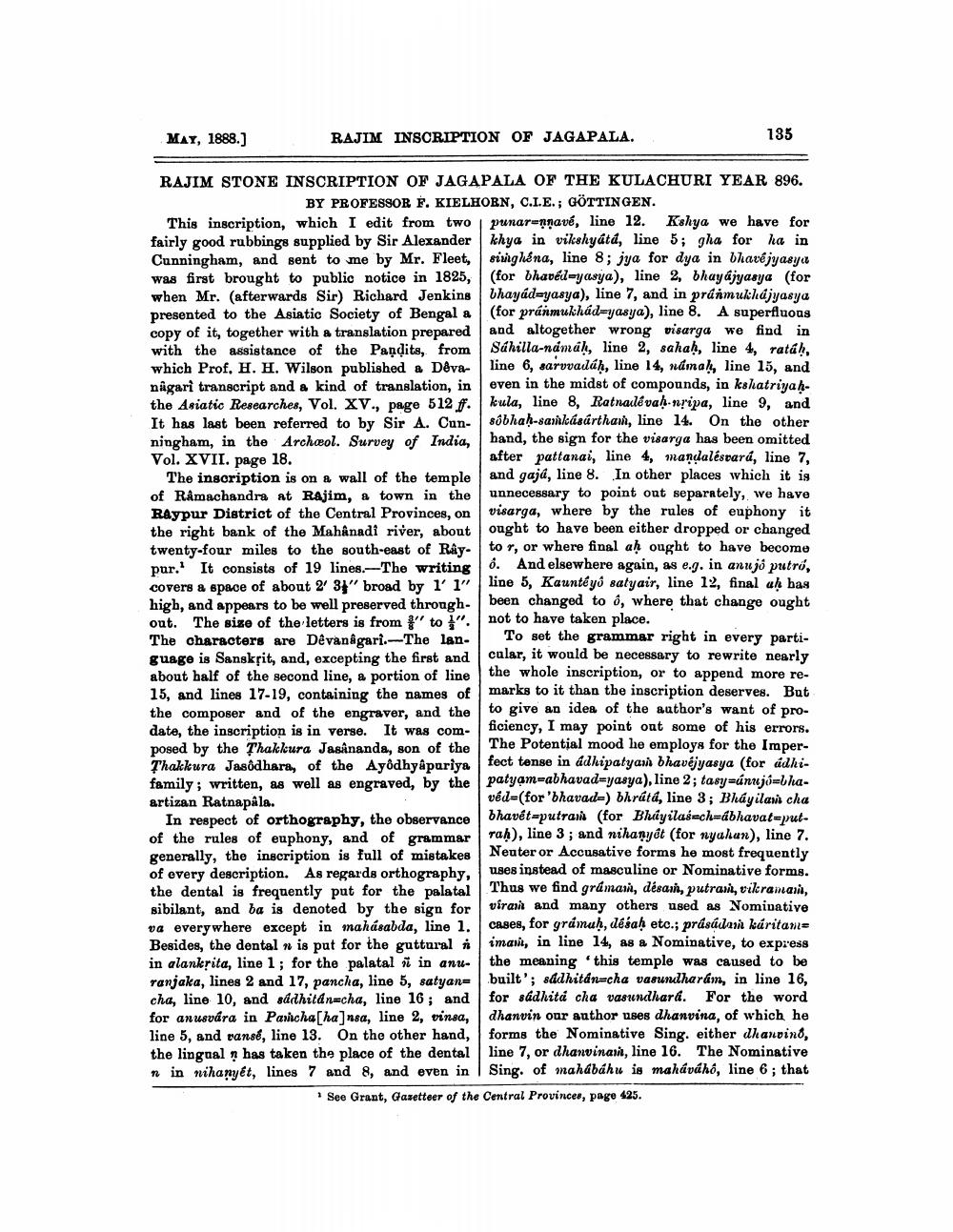________________
MAY, 1888.)
RAJIM INSCRIPTION OF JAGAPALA.
135
RAJIM STONE INSCRIPTION OF JAGAPALA OF THE KULACHURI YEAR 896.
BY PROFESSOR F. KIELHORN, C.I.E.; GÖTTINGEN. This inscription, which I edit from two punar=nnavé, line 12. Kshya we have for fairly good rubbings supplied by Sir Alexander khya in vikskyátů, line 5; gha for ha in Cunningham, and sent to me by Mr. Fleet singhéna, line 8; jya for dya in Dharéjyasya was first brought to public notice in 1825, (for Whaved-yasya), line 2, bhaydjyasya (for when Mr. (afterwards Sir) Richard Jenkins Thayádayasya), line 7, and in prdimukhdjyasya presented to the Asiatic Society of Bengal a (for prámukhád=yasya), line 8. A superfluous copy of it, together with a translation prepared and altogether wrong visarga we find in with the assistance of the Pandits, from Sáhilla-namál, line 2, sahah, line 4, ratáh, which Prof. H. H. Wilson published a Déva- line 6, saruvarláh, line 14, námah, line 15, and nagari transcript and a kind of translation, in even in the midst of compounds, in kshatriyahthe Asiatic Researches, Vol. XV., page 512 ff. kula, line 8, Ratnailé vah-nripa, line 9. and It has last been referred to by Sir A. Cun- sõbhah-sakásárthana, line 14. On the other ningham, in the Archeol. Survey of India, hand, the sign for the visarga has been omitted Vol. XVII. page 18.
after pattanai, line 4, mandalesvará, line 7, The inscription is on a wall of the temple and gaja, line 8. In other places which it is of Ramachandra at Rajim, a town in the unnecessary to point out separately, we have Reypur District of the Central Provinces, on visarga, where by the rules of euphony it the right bank of the Mahanadi river, about | ought to have been either dropped or changed twenty-four miles to the south-east of Ray- tor, or where final aḥ ought to have become pur. It consists of 19 lines. The writing o. And elsewhere again, as e.g. in anuji putró, covers a space of about 2' 3" broad by 1' 1" line 5, Kaunté yo satyair, line 12, final ah bas high, and appears to be well preserved through-|
be well preserved through. been changed to 6, where that change ought out. The size of the letters is from " to ". not to have taken place. The characters are Devanagari.--The lan. To set the grammar right in every partiguage is Sanskrit, and, excepting the first and calar, it would be necessary to rewrite nearly about half of the second line, a portion of line the whole inscription, or to append more re15, and lines 17-19, containing the names of
marks to it than the inscription deserves. But the composer and of the engraver, and the to give an idea of the author's want of prodate, the inscription is in verse. It was com- ficiency, I may point out some of his errors. posed by the Thakkura Jasananda, son of the The Potential mood he employs for the ImperThakkura Jasodhara, of the Ayodhyâpuriya fect tense in adhipatya bhavėjyasya (for adhifamily; written, as well as engraved, by the patyam-abhavad=yasya), line 2; tasy-únnjówlhaartizan Ratnapala.
véd=(for 'bhavad-) bhrúta, line 3; Bhayilan cha In respect of orthography, the observance bhavét-putrail (for Bhaiyilasech-ábhavat=putof the rules of euphony, and of grammar
rah), line 3 ; and nihanyét (for nyahun), line 7. generally, the inscription is full of mistakes Neuter or Accusative forms he most frequently of every description. As regards orthography, uses instead of masculine or Nominative forms. the dental is frequently put for the palatal
Thus we find grámasi, désasi, putras, vikramasi, sibilant, and ba is denoted by the sign for
viral and many others used as Nominative va everywhere except in mahásabda, line 1. cases, for grámuh, désah etc.; prásácan káritan= Besides, the dental is put for the guttural i imani, in line 14, as a Nominative, to expres in alankesita, line 1; for the palatal i in anu- the meaning this temple was caused to be ranjaka, lines 2 and 17, pancha, line 5, satyan= built'; sddhitán-cha vasunulharam, in line 16, cha, line 10, and sádhitán=cha, line 16; and for sádlitá cha vasundhark. For the word for anusvára in Pascha[hansa, line 2, vinsa, dhanvin our author uses dhanvina, of which he line 5, and vansé, line 13. On the other hand, forms the Nominative Sing. either dhanvino, the lingual n has taken the place of the dental line 7, or dhanvinant, line 16. The Nominative a in nihanyét, lines 7 and 8, and even in Sing. of mahabáhu is maháváho, line 6; that
See Grant, Gasetteer of the Central Provincer, pago 125.




